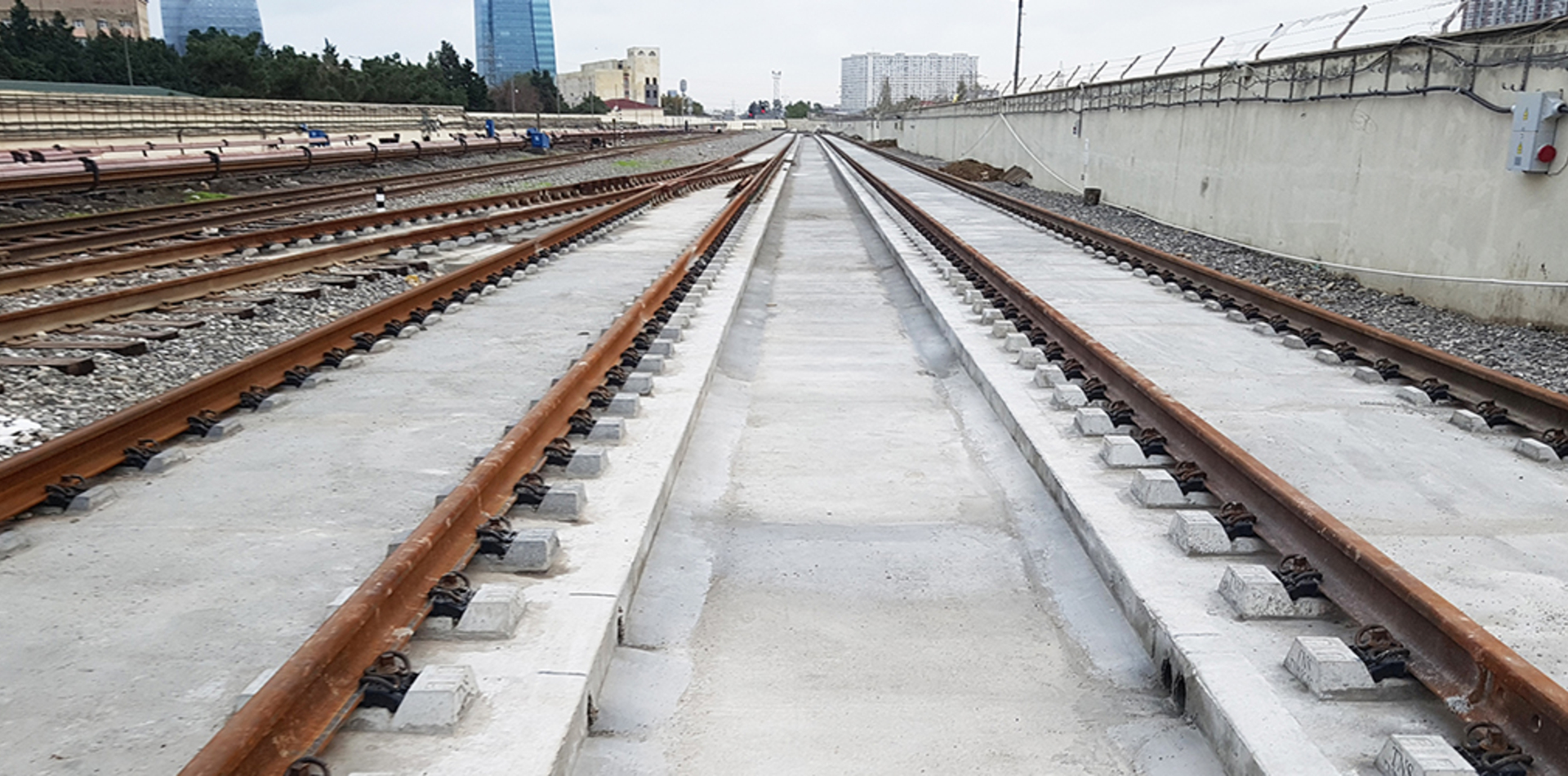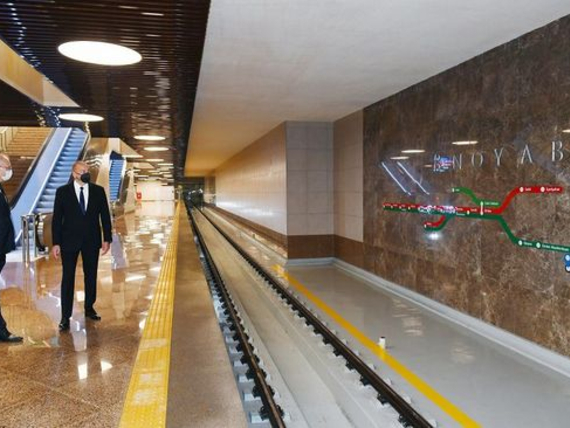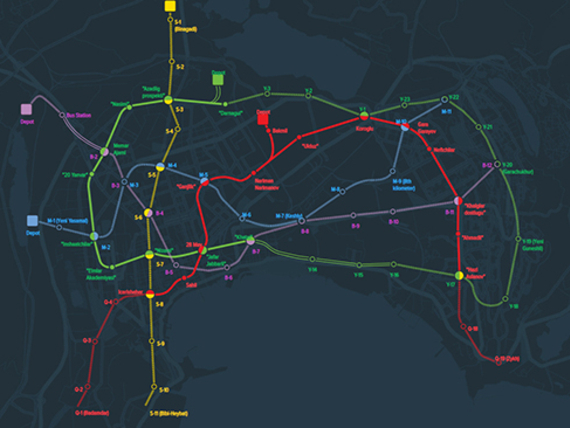The construction project is part of Baku's development plan to become one of the new megacities in the Caspian region. At the same time, it is a central aspect in the renewal and expansion of the metro network to a total length of 119 kilometers by 2030. Thanks to oil and gas, economic growth has increased by 35% in the last ten years alone. The infrastructure of this metropolis of 2.2 million people is barely keeping pace with this growth dynamic. On a network of currently 36.7 kilometers, more than 720,000 passengers are transported daily between the 25 tunnel stations. By 2030, 55 new subway stations are planned, three new lines and Line 3 are to be completed and extended as a ring line.
The French engineering firm Systra in Paris, a specialist in the design and development of rail transport and urban rail-based public transport, has drawn up a master plan for the mega project costing 5.6 billion euros. On board since the beginning of 2015: Weinsberg-based concrete plant specialist Vollert. "Our task was to redesign the entire track system, to design the new sections accordingly, to solve the interfaces to the existing track system, but also to redesign existing, dilapidated sections. At the same time, we were commissioned with the planning of a concrete sleeper production plant," describes Igor Chukov, Executive Sales Director CIS/Russia at Vollert. In cooperation with Dipl.-Ing. Jürgen Rademacher from the Büro für Verkehrsingenieurbau in Berlin and Dipl.-Ing. Andreas Titze, specialist for concrete technology, the project planning phase started in 2016.
Vollert-Rheda system in the superstructure
The existing track network of the Baku metro goes back to an original form of slab track. After the rails have been installed, tar-impregnated wooden sleepers are underlaid with concrete and a channel is kept clear in the middle for drainage. However, wooden sleepers are comparatively short-lived. They require frequent maintenance and costly repairs. In subway tunnel systems, this can only be done by temporarily shutting down the entire section of track, which entails a high loss of revenue.
"Steel-concrete sleepers require less maintenance, are more environmentally friendly and much more durable. And they have the advantage of providing more stability due to their greater dead weight," explains Jürgen Schäfer, the project manager responsible at Vollert. For the construction of slab tracks in the new line sections, Vollert relied on the Rheda system instead of a conventional ballast-sleeper construction method. It consists of a strong, hydraulically bound base course on which a reinforced concrete slab is placed. The concrete sleepers are aligned on this and fixed with filler concrete, which is connected to the lower bearing slab by reinforcement. Compared with conventional ballasted track, however, the system is very firm and offers little elasticity. "We have dealt with the issue very intensively and developed a special design for the superstructure," explains expert Jürgen Rademacher. The Vollert-Rheda system elegantly solves the type of fastening. It is fixed quickly and easily with just one dowel. This simplifies installation work, as well as subsequent maintenance and servicing work. The fastening technology developed together with Vossloh also irons out the disadvantages of slab tracks: it reduces noise, absorbs vibrations, takes over damping and thus offers high ride comfort for passengers.
First milestones realized in several construction phases
At the end of May 2021, the central metro station 'November 8' was opened within Metro Line 3. In the process, the section between the Avtovaghzal, Memar Ajami and 8th November metro stations was newly built on the basis of the Vollert-Rheda system. This is special because 'November 8' is considered an important junction between metro lines 3 and 4 and plays a central role in connecting downtown Baku to the metro network. This was preceded by a number of important planning phases. In the process, a whole series of questions were solved: For example, how must the substructure for the slab track in the tunnel sections lined with tubbings be constructed? What type of reinforcement is to be used? How strong must the concrete be and what type of concrete is best suited? What is the best solution for waste water? What kind of turnouts can be planned and how are they fixed to the concrete? And what needs to be considered at the transition to the sections with wooden sleepers?
In the actual, first construction phase, the old wooden sleepers were removed in the affected section and the existing concrete foundation was demolished. At the same time, extensive pipelines were laid to bring the ready-mix concrete to the construction site and important wastewater issues were resolved. In the second construction phase, a concrete layer was first laid for a smooth underside of the track before the steel plate was fixed, further superstructure elements were laid, the conductor rails were installed and the concrete sleeper blocks were connected to the supporting plate via the reinforcement installed. The sleepers were transported to the construction site just-in-time in individual daily sections during the entire construction phase.
"For the concrete sleepers themselves, we didn't want to rely on imports from abroad," explains Zaur Huseynov, CEO of Baku Metropolitan. "Just-in-time means we have to supply the construction sites quickly and reliably. During the preliminary planning, it also became clear that the plant location should be as central as possible within reach of the planned modernization and new construction sections in order to keep transport times short and costs low." At the beginning of 2017, the first sleeper block was produced at the new Baku Metropolitan concrete plant. For the plant technology, the company relied on a partially automated concept and the proven machine technology from Vollert. For the special environmental conditions in Baku with maximum temperature differences in summer and winter, a proprietary concrete recipe and a test plan for continuous quality assurance for fresh and hardened concrete testing were created. The novel sleeper design was laid out by Vollert engineers with regard to the maximum axle load of 15 tons and the maximum top speed of the metro trains of 50 km/h, and the design parameters for the structural analysis were also adjusted. All this ensures optimum stiffness and uniform distribution of the vibration force. With 20 formwork molds, up to 30,000 sleepers are currently produced annually, which corresponds to a daily production of approx. 1,300.
Further subsections in preliminary planning until 2030
Prior to the installation of the first slab tracks in the track network of Baku Metropolitan, extensive testing and analysis phases were initially carried out in 2018 by experienced rail specialists from Baku Metropolitan and Vollert engineers. For this purpose, a 800 m long test track was installed near the Narimanov metro depot and operation under real conditions was simulated. The novel Vollert-Rheda system also successfully passed extreme situations according to the highest standards and international norms, so that in a further pilot phase in 2020 the replacement of the first track systems in the Khatai and Narimanov metro stations on Line 3 took place, with initially only one track being completely renewed at a time. During the pilot phase, as well as in the new construction phases that have now taken place, Vollert took over construction supervision for individual project steps. "This is the only way we can also ensure that our track concept is implemented as planned," says Igor Chukov in this regard. "The commissioned engineers are constantly present and monitor the further construction progress."
Until 2030, the first step will be the continuous replacement of the existing slab tracks with wooden sleepers by the Vollert-Rheda system. In parallel, the expansion of metro lines 1-4 will be pursued, more than 50 new metro stations will be built and the current total length of the metro network of 37 km will be almost quadrupled. "We are looking forward to and proud to play a major role in the modernization and expansion of the metro network in Baku," says Igor Chukov. "Through this, Baku will continue to grow into a modern megacity. The metro will be the elementary lifeline to transport annual passenger numbers of up to one million, ensuring the capital's prosperity and quality of life."








